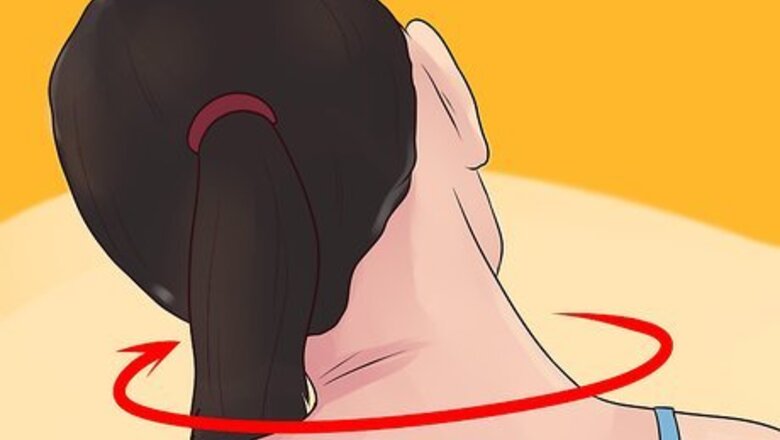
views
Learning the Basics
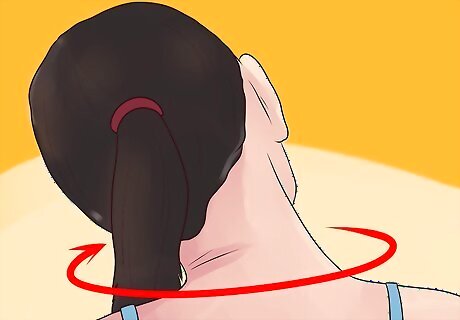
Work on your flexibility. Being flexible is one of the most important qualities of a gymnast. If you want to be a gymnast, you can start working on your flexibility right now. Doing stretches and other exercises every day will make your body more limber, allowing you to perform gymnastics moves with grace and ease. Being flexible also improves your coordination. To improve your flexibility, do these exercises every day: Do neck rotations and try to bring your ears as close as possible to your shoulders without raising them. Next is the shoulder stretch, where you pull one arm at a time across your chest. Stretch your chest by locking your fingers behind your back and extending your arms up. Stretch your back with the seal stretch: get in a push up position, then push up keeping your hips on the ground. Stretch your hamstrings and back by leaning forward to touch your toes. Practice doing the splits until you can go into a full split with ease. Starting from a sitting position, do a knee to chin press. Bring one knee toward your chin, hold it there, then repeat with the other knee. Do bridges. Start lying down with your knees bent. Put your hands on the floor behind your head and lift your body into a bridge position. Don't be afraid to start out slow—you don't need to do a bunch of fancy stretches and yoga poses right away! Do your stretches for 10-30 seconds when your're first starting out. Everything should be in moderation!

Learn how to do a forward roll. It's a fun gymnastics move that will help you get used to using your body in more flexible ways than you're used to. You'll also learn how it feels to be upside down. To start, crouch close to the ground with your hands firmly planted on the floor. Tuck in your head and roll forward onto your back, letting your legs follow naturally. Keep practicing until you can do a forward roll without thinking. Make sure you keep your head tucked in, and don't roll directly on your neck. You could injure your neck if you put all of your weight on it. Try a more advanced version of the forward roll by starting from a standing position and smoothly rising to your feet without using your hands to support you at the end of the move.

Practice doing a cartwheel. Find a soft or grassy spot to practice doing a cartwheel. This isn't a dangerous move, but you might fall a few times before you get the hang of it. Start in a standing position with your right toe (or your left, if you're left-handed) pointed in front of you and your hands above your head. Lean forward sideways, and place your right hand on the ground, following by your left hand. As your hands touch the ground, kick up your legs and use your arms to support their weight. Your left foot should touch down first, then your right. End the move standing upright. The first few times you try to cartwheel, it will be hard to get your legs above your head. Keep practicing until you're used to the feeling of being upside down. Eventually, you should be able to cartwheel without bending your knees. To do a roundoff, try landing with both feet at the same time instead of one at a time. Keep your feet together and plant them on the ground.
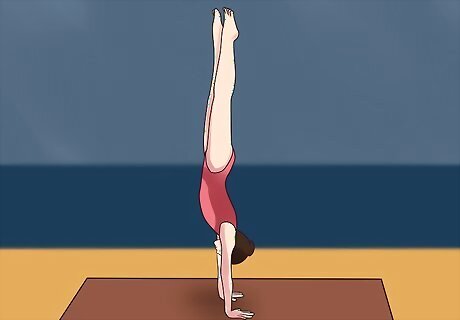
See if you can do a handstand. This is the foundation of many gymnastics moves, and it's one you can perfect at home before you get lessons. Find a soft place to practice. Stand up straight with your hands over your head. Step forward with your right foot (or your left, if you're left-handed) and tip forward to plant your hands on the ground. At the same time, kick up your legs above your head, keeping them straight and together. Hold the position for a moment before dropping your feet back to the ground and standing upright. It might help to practice against the wall, or with the help of the spotter, while you're learning this move. Keep your chin tucked in and your shoulders against your ears. Don't lift or raise your head while you do a handstand.
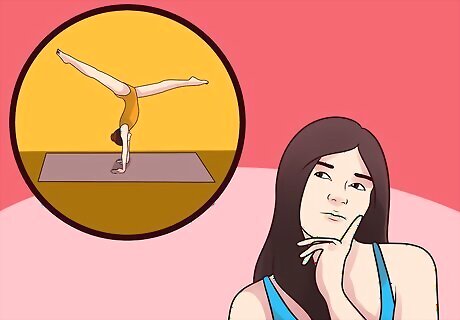
Take gymnastics lessons. If you think you have an aptitude for gymnastics, and you're ready to try more complicated moves, it's time to take some lessons. A qualified gymnastics coach will teach you how to do advanced moves using the right form. You'll learn how to strengthen your muscles so that you can execute moves with perfect grace. Also importantly, your coach will be able to show you how to train without risking your safety. You can teach yourself at home gymnastics skills like a round-off, a front walkover, and a back walkover. In a gymnastics gym, you'll get to learn how to use professional equipment. For girls, vault, balance beam, uneven bars, and floor exercise. For boys, vault, high bar, still rings, parallel bars, pommel horse, and floor exercise. handsprings, front tucks, back tucks, aerials, front aerials, etc.. To find gymnastics lessons near you, do an online search for “gymnastics gym” or “gymnastics club” and the name of your town. You'll probably find a range of options, from free lessons offered at your local YMCA to more expensive private lessons. At clubs, your skill level will be evaluated and you'll be instructed as to what class would fit you best.
Thinking Like a Gymnast

Be fearless with your body. Gymnasts throw their bodies through the air headfirst like it's no big deal. To be a good gymnast, you have to be willing to take physical risks for the sake of seeing what your body is capable of. It's normal to feel butterflies before trying a new move on the high bar or doing a flip on the balance beam, but you'll need to be able to push through the jitters if you want to excel. The more you practice, the less frightening it will be. While gymnastics does involve risk, with the help of a coach you'll learn how to minimize the dangers by using the correct form. Your instructor won't have you try a move he or she doesn't think you're advanced enough to try. You will fall many, many times as you train to become a gymnast. You'll have to pick yourself up and keep going. The further the advance, the more tears and pain you'll experience. However, if you're a determined gymnast, the results will be worth everything it takes to get good. Concentrating on the task at hand is a good way to overcome fear. If you're thinking deeply about what your body needs to do, you won't be as worried about messing up.

Eat an athlete's diet. Your body will be more able to move the way it needs to if you nourish it with healthy food. Athletes need plenty of calories to keep their muscles strong, but it's important not to eat so much that your body feels heavy when you're trying to perform. A healthy athlete's diet includes the following: Plenty of fruits, vegetables, nuts, and other plant-based foods that are as unprocessed as possible. Lean meat, dairy, and other good sources of protein. Whole grains and legumes to provide carbohydrates for energy. Avoid sugary foods, sodas, processed foods, and anything that makes you feel less energetic. Don't forget to stay hydrated, too: drink six to eight glasses of water per day, especially before and after practicing. A low-fat diet plan is best if you're specifically focused on gaining muscle mass.

Strengthen your mind-body connection. Being a gymnast is in some ways like being a dancer. A gymnastics performance involves style and grace, just like dancing does. Gymnasts and dancers both have a special mind-body connection that's rare to see. It's a special awareness of what their bodies can do, and an ability to move with pure confidence. Doing physical activities that feel exhilarating and fun can help strengthen your ability to make your body do amazing things. Consider giving one of these ideas a try: Take dance lessons. Try hip hop, salsa, or beginner's ballet. If you don't want to take lessons, just go out dancing and lose yourself as you move your body to the music. Try martial arts. Try capoeira, karate or ju jitsu. Practice yoga. It's a great way to get in tune with your body and improve your flexibility, too.

Be willing to work your hardest. The willingness to work hard day in and day out is a hallmark of every successful gymnast. Getting good at gymnastics moves takes so much practice that there's really no way to avoid working hard. Even amateur gymnasts might train as often as four hours a day, four times a week, with light practice and stretching on days in between. In addition to working hard, if you end up deciding you want to pursue professional gymnastics, you may have to make some sacrifices. You probably won't have time for other extracurriculars, and your social time will be limited since you'll have to stay in good shape for practice and competitions.

Aim for perfection. Every move must be practiced over and over until you execute it perfectly. If you're not a perfectionist, this repetition might get frustrating. However, it's your coach's job to help you reach perfection, since in a competition every movement you make will be judged. Having perfect form is also the best way to keep yourself from getting injured; a bent knee or waist could throw you off balance just enough to cause a bad fall from the balance beam. Gymnasts have a reputation for being determined perfectionists, but this approach to life can backfire as well. Don't take it so far that you damage your health or injure yourself just to get a move right. Know your limits, and take a break when you need to.
Advancing to Elite Status
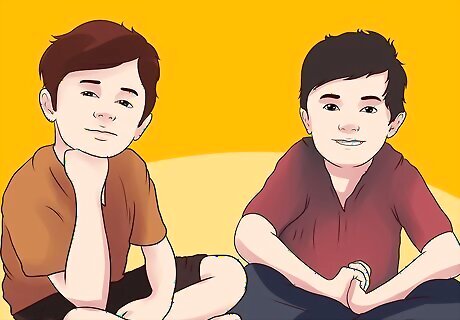
Start early and train hard. As soon as you know you want to be a gymnast, start taking lessons right away so that your body learns flexibility from an early age. As you work with a coach and improve your skills, you'll advance from beginner level to higher levels, and eventually you'll be good enough to compete. It's important to develop flexibility and muscle memory as soon as possible, since these qualities are harder to attain at an older age. To be a great athlete, you'll need to be willing to put in the work. You'll have to be willing to practice at higher levels than most people, and keep going even when things get tough. If you decide you want to be an elite gymnast, get your skill level assessed so you know exactly where you stand and how much work you'll need to put in to advance to the next level. If you're on the older side, you can still become a good gymnast, but it may be more difficult to compete at very high levels. Many gymnasts reach their peak before age 18.
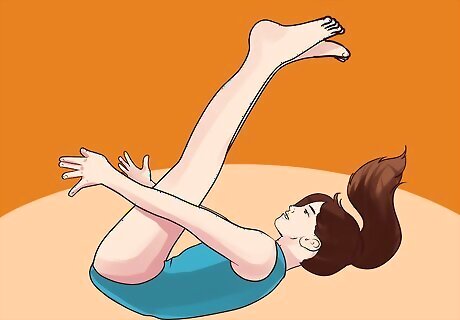
See if your body type fits the role. While anyone can gain flexibility and find out what their body can do, professional gymnasts tend to have a certain body type that's conducive to flying and flipping through the air. They're usually on the shorter side and very slight, but strong. If you're growing quite tall, or if your body tends to be stocky, being a professional gymnast might not be in the cards. Work with a trainer to find out whether hard work will help your body get to where it needs to be to compete on an elite level. With the right kind of training, you might still be able to be a gymnast. Don't be hard on yourself if it turns out that your genes aren't lining up with your desire to be a gymnast. It's not worth starving yourself or trying to stunt your growth; don't put your health at risk. Try pursuing an athletic endeavor that isn't so dependent on being slight.

Find a professional coach and enter competitions. A gymnast will not succeed without a brilliant coach helping him or her along the way. When you start getting serious, ask around and track down the best coach in your area as soon as possible. Work with your coach to improve your skills to the point where you can start entering professional competitions. You probably won't find who you're looking for at your local YMCA or club gym. In fact, you might have to travel to a different city to work with the best coach available. When your skill level is high enough, you can compete as part of a team. Each team will have certain requirements your coach will help you meet. Watch videos of Olympic gymnasts like Gabrielle Douglas, Simone Biles, Aly Raisman, Laurie Hernandez, Nastia Luikin, and Aliya Mustafina to see their artistry and technique, which will help you in competition. Look for a USA Gymnastics safety-certified center with coaches who have professional memberships.

Devote your life to gymnastics. At the elite level, your life will become gymnastics. Half of the day, almost every day, will be spent training. You'll learn top-level skills that you simply couldn't master any other way. If you want to compete with the very best, you'll have to become a gymnastics expert, and that means making gymnastics the most important part of your daily routine. Many elite gymnasts are homeschooled, giving them the flexibility to spend half their days training. There's not much time for other extracurricular activities. In order to work with the best coaches and teams, you might have to move to a new city, or even a new country, as many elites have done. The reward for devoting your life to gymnastics will be seeing your body do amazing things — and maybe earning some medals, too.















Comments
0 comment